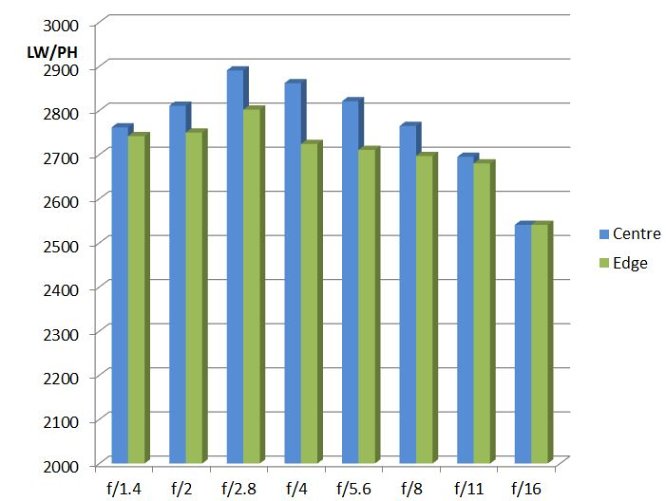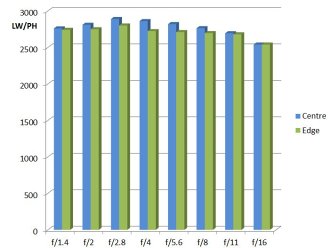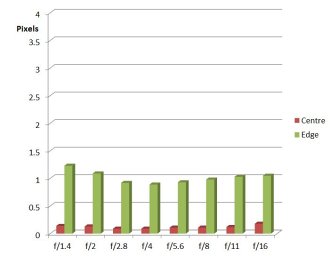Sigma 30mm f/1.4 DC DN C Review
Sigma 30mm f/1.4 DC DN C Performance
Once we start to look at the performance, things become rather more exciting.
Sharpness is of a very high order indeed and is probably the crowning glory of the lens. Centrally, the results are excellent wide open at f/1.4 and outstanding between f/2 and f/5.6. This excellence continues all the way through to f/16. Obviously the figures do drop as diffraction takes its toll, but they still remain well within the band that we describe as excellent.
The edges are excellent at all apertures, peaking at f/2.8 where the figures nudge upwards to being described as outstanding. f/2.8 is the peak of the lens performance right across the frame. The outcome of this is some lovely crisp images, full of detail. The gradation is also excellent, giving us that indefinable “look” to the images that lifts it out of just being a technical exercise in resolution. The overall performance is extremely well balanced.
How to read our charts
The blue column represents readings from the centre of the picture frame at the various apertures and the green is from the edges.The scale on the left side is an indication of actual image resolution as LW/PH and is described in detail above. The taller the column, the better the lens performance.
For this review, the lens was tested on a Sony Alpha A7R II using Imatest.
CA (Chromatic Aberration) is very much under control, especially at the centre. At high contrast boundaries some CA can be seen at the frame edges, but it really is not much of a problem in most circumstances. In any event, this can be corrected in software, if felt necessary.
How to read our charts
Chromatic aberration is the lens' inability to focus on the sensor or film all colours of visible light at the same point. Severe chromatic aberration gives a noticeable fringing or a halo effect around sharp edges within the picture. It can be cured in software.Apochromatic lenses have special lens elements (aspheric, extra-low dispersion etc) to minimize the problem, hence they usually cost more.
For this review, the lens was tested on a Sony Alpha A7R II using Imatest.
Flare is not a problem either and clearly the lens design and coatings are well thought out and highly effective. Shots against the light retain their saturation and contrast, an impressive result.
The bokeh likewise is lovely, the almost circular aperture contributing to a wonderful smooth look to the out of focus areas.
Distortion is the biggest lens defect and we are presented with -2.95% barrel. This can clearly be seen where straight lines are at the frame edges, although here too this can be corrected in software. Some correction in architectural shots might well be routinely necessary.
Value For Money
There is not much in way of a direct competitor for this lens, perhaps the Sony E 35mm f/1.8 OSS (£349) or the Zeiss Touit 32mm f/1.8 (£419) being the closest.
There is also a Samyang 35mm f/1.4 AS UMC at £389, but this is manual focus only. Likewise the Samyang 35mm T1.5 AS UMC II at £419.
With such a splendid performance from the Sigma 30mm f/1.4 DC DN Contemporary lens, who could argue with the modest £249 price tag?
For more options have a look at the Top 10 Best Sigma lenses.
Add your message
Please login here or if you've not registered, you can register here. Registering is safe, quick and free.
photodo Stats
428 MTF tests
74 in-depth photodo reviews
100+ users join each day
Help the lens community by reviewing or rating a lens today via our lens search
Latest Lens Reviews
- Chinon 28mm f/2.8 Vintage Lens Review
- Canon EF 70-200mm f/4L IS II USM Lens Review
- Samyang AF 85mm f/1.4 EF Review
- Sigma 70mm f/2.8 DG Macro Art Review
- Samyang AF 24mm f/2.8 FE Review
- Meike 50mm f/1.7 Review
- Tamron 70-210mm f/4 Di VC USD Review
- Lensbaby Burnside 35mm f/2.8 Review
- Asahi Super Takumar 50mm f/1.4 Review
- Asahi Super-Multi-Coated Takumar 135mm f/3.5 Review



